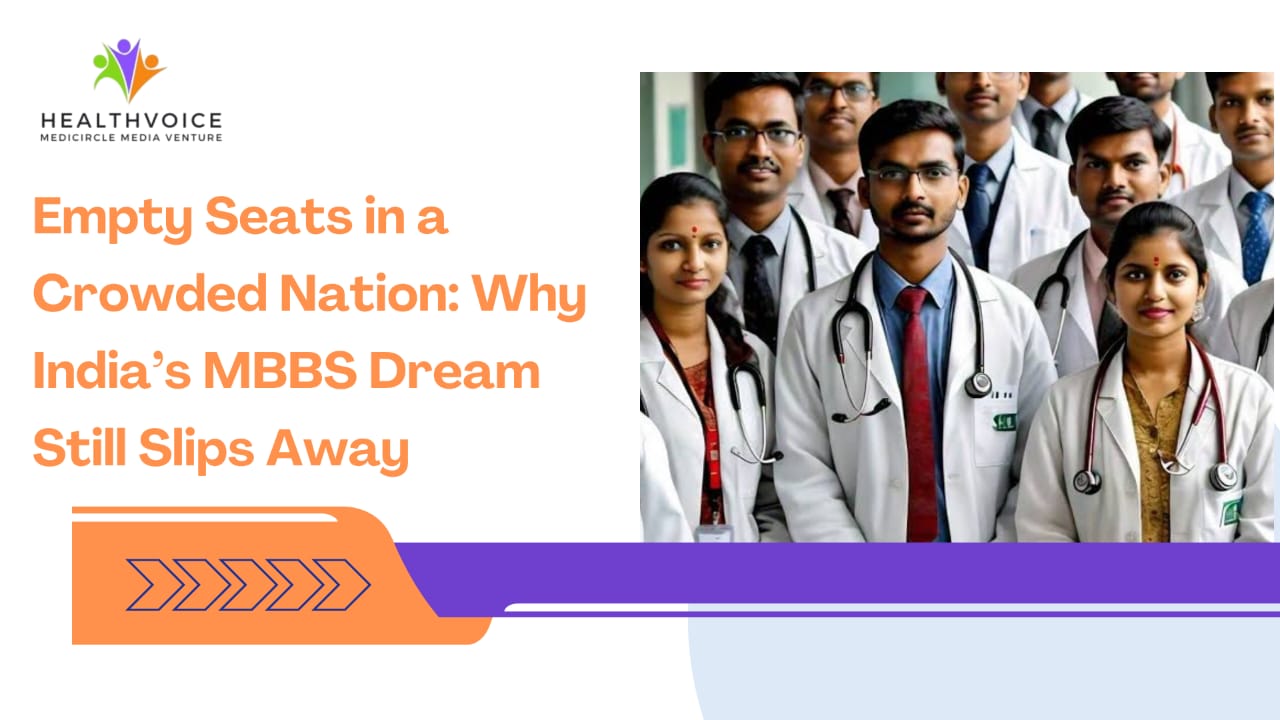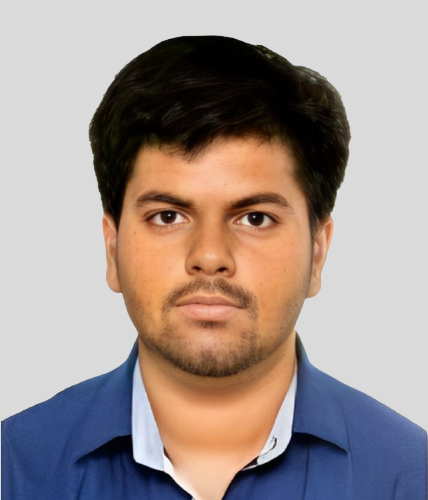Empty Seats in a Crowded Nation: Why India’s MBBS Dream Still Slips Away
Every unoccupied seat should be viewed not as a statistic but as a warning which reminds policymakers, educators, and the medical fraternity that without addressing the barriers that keep students away, the dream of healthcare for all will remain out of reach.

In a country where the very mention of a medical seat sparks years of preparation, sleepless nights, and the unrelenting ambition of families who see their children as future doctors, the reality of vacant MBBS seats is a paradox that cannot be ignored. India, with its massive population, expanding healthcare needs, and loud calls for more doctors in every district, is watching an unusual phenomenon unfold where thousands of undergraduate medical seats lying unfilled year after year. According to the data presented in Parliament, nearly 11,966 undergraduate medical seats have remained vacant across the country in just the last four academic cycles. This revelation forces us to confront a question that cuts deeper than the statistics, how does a nation desperate for doctors allow medical seats to go to waste?
The highest number of vacancies appeared in the academic year 2022–2023, when over four thousand MBBS seats failed to find takers. For a profession that is considered one of the most aspirational, where cut-offs remain high and competition intense, such figures look puzzling at first glance. If millions of students appear for entrance exams, how do thousands of seats escape allocation? The story is far more complex than simple demand and supply. It speaks of systemic gaps, affordability issues, uneven geographical distribution of institutions, and the fine balance between increasing capacity and ensuring quality in medical education.
It is undeniable that India has been on an expansion spree in terms of medical colleges. Over the past few years, the government has projected a significant increase in the number of MBBS seats, pushing the figure from around 83,000 in 2020–21 to nearly 1.16 lakh today. States such as Uttar Pradesh, Tamil Nadu, Karnataka, Maharashtra, and Gujarat have seen some of the highest additions, with Uttar Pradesh alone witnessing a jump from 7,428 seats to over 12,000 in just four years. In smaller northeastern states too, long-neglected medical infrastructure has finally started to change, with Nagaland opening its first 100 MBBS seats, Meghalaya tripling its intake from 50 to 150, and Arunachal Pradesh doubling its capacity. On paper, this looks like a success story of expansion, yet the reality of vacant seats suggests that rapid growth is not solving the larger puzzle.
One cannot ignore the role of cost in this mismatch. While government medical colleges remain highly sought after for their affordability and reputation, a significant portion of newly added capacity has come from private institutions, where fees often run into several lakhs per year. For many middle-class families, even with loans, this burden becomes unmanageable. The dream of donning a white coat is crushed not by lack of capability but by the weight of financial constraints. Vacant seats in private colleges are less a sign of disinterest in medicine and more a reflection of economic inequity. At the same time, students who narrowly miss out on government college admissions often find themselves with no viable alternative, leaving seats in expensive institutions unoccupied.
Geography adds another layer to this issue. Many of the new colleges established under centrally sponsored schemes are located in underserved or aspirational districts, which was precisely the government’s intent to bridge healthcare access gaps. Yet, convincing students and families to move to relatively remote or less developed towns is not always easy. Concerns about infrastructure, safety, and long-term career opportunities in such areas discourage many from accepting admissions, particularly when alternatives exist in urban centers. Thus, even when seats are technically available, their distribution often creates barriers for aspirants.
The government, however, has not been blind to these challenges. The framing of the Minimum Standard Requirement Regulations, 2023, by the National Medical Commission was intended to ensure that the mushrooming of colleges did not come at the cost of quality. By mandating minimum bed strength, compulsory research units, structured faculty norms, and clinical exposure requirements, the aim was to guarantee that medical students would receive a robust education regardless of where they studied. The introduction of clear rules against private practice during college hours, mandatory urban and rural postings, and structured outpatient attendance benchmarks was supposed to ensure a hands-on, ethically sound medical training ecosystem. Yet, these very rules also add cost and complexity to running colleges, often inflating fees and deterring potential students. It is a delicate balance between safeguarding quality and ensuring accessibility.
Beyond the institutional side, the problem of vacant MBBS seats is a mirror to the deeper structural flaws of India’s education-to-employment pipeline. Students face years of coaching, entrance exams, and financial pressure, only to encounter bottlenecks in postgraduate opportunities after their undergraduate course. The fear of being stuck in limbo after MBBS, with inadequate postgraduate seats and fierce competition for specialization, makes some aspirants reconsider whether the investment in a private MBBS degree is worth the risk. The numbers reflect not just vacant seats, but the anxieties of a generation that is acutely aware of the uncertainties that lie beyond graduation.
At the policy level, the government has pointed out that the increase in seats is part of a larger vision. Centrally sponsored schemes for upgrading district hospitals into medical colleges, the construction of superspecialty blocks under the PMSSY scheme, and the rollout of new AIIMS institutions across the country are all steps meant to create both more doctors and more equitable distribution of healthcare services. Already, 131 new medical colleges have become functional under such schemes, with 22 AIIMS projects approved and 19 already admitting undergraduate students. These efforts are commendable and show an intent to tackle India’s historic shortage of doctors. However, the persistence of vacant seats indicates that expansion alone cannot address deeper issues of affordability, perception, and career security.
The paradox becomes starker when one recalls that India continues to face a doctor-patient ratio challenge, still struggling to meet the World Health Organization’s recommended standards. Rural areas remain severely underserved, with families walking miles to access basic medical care. Primary health centers often function without doctors, and referral hospitals struggle with overburdened staff. In such a context, vacant MBBS seats are not just a bureaucratic anomaly but a painful irony. Each empty seat represents a lost opportunity for one more trained doctor to enter the system, one more chance to close the gap between healthcare demand and supply.
For healthcare professionals observing this trend, the situation calls for reflection and advocacy. Doctors who have lived through the grind of training understand better than anyone the sacrifices required to reach that position. When seats are left unfilled, it indicates a broken link in the chain, where aspiring doctors are falling through gaps created by cost, geography, or policy. As a professional community, it becomes important to push for solutions that ensure affordability through scholarships, greater financial support, or structured loan repayment schemes tied to service in underserved areas. Equally, there is a need to reframe the narrative around new medical colleges in smaller towns, building trust in their ability to provide quality training and career opportunities.
The answer may also lie in better alignment between undergraduate and postgraduate opportunities. If students had confidence that completing MBBS would reliably open pathways into specialization and stable employment, fewer would hesitate at the thought of investing in a degree. The imbalance between UG and PG seats creates a bottleneck that dissuades many from pursuing expensive options. Increasing PG seats, expanding residency opportunities, and creating structured career progression pathways could significantly improve the attractiveness of medical education.
Another dimension that demands attention is the role of communication and counseling in admissions. Many students and families remain unaware of options, fee structures, and support mechanisms available, leading to hasty decisions or missed opportunities. Transparent and accessible information could prevent avoidable vacancies and help match deserving candidates with available seats.
In the long run, the vacancy of seats despite rising demand for doctors forces India to reconsider how it defines success in expanding medical education. Numbers alone, whether in terms of colleges, seats, or projects approved cannot reflect true progress unless every seat translates into a trained, motivated, and well-placed doctor serving the community. The human resource crisis in healthcare will not be solved by quantity without equal attention to distribution, affordability, and quality.
The story of 11,966 vacant seats over four years is not merely about statistics shared in the Lok Sabha. It is a story of lost potential, of young aspirants unable to bridge the financial or geographical gap, of a healthcare system that desperately needs more professionals yet fails to absorb the willing. It is a story that highlights the urgency of reform, the necessity of aligning policy with ground reality, and the moral imperative of ensuring that no seat is wasted in a nation that cannot afford to waste doctors.
India stands at a crossroads where its ambition to lead in global healthcare must begin at home, with robust reforms in medical education. The suspension of seats into vacancy must be turned into opportunities for future physicians. Every unoccupied seat should be viewed not as a statistic but as a warning which reminds policymakers, educators, and the medical fraternity that without addressing the barriers that keep students away, the dream of healthcare for all will remain out of reach. The stethoscopes that could have been hung around the necks of thousands of new doctors will remain silent unless urgent steps are taken. And silence, in this case, is something the country cannot afford.
 Sunny Parayan
Sunny Parayan
#healthvoice #MBBSVacancies #IndiaNeedsDoctors #MedicalEducation #AffordableMedicalEducation #FutureDoctors #DoctorShortage #HealthcareForAll #EducationReform #DoctorsForIndia #StrengthenHealthcare #HealthEquity
